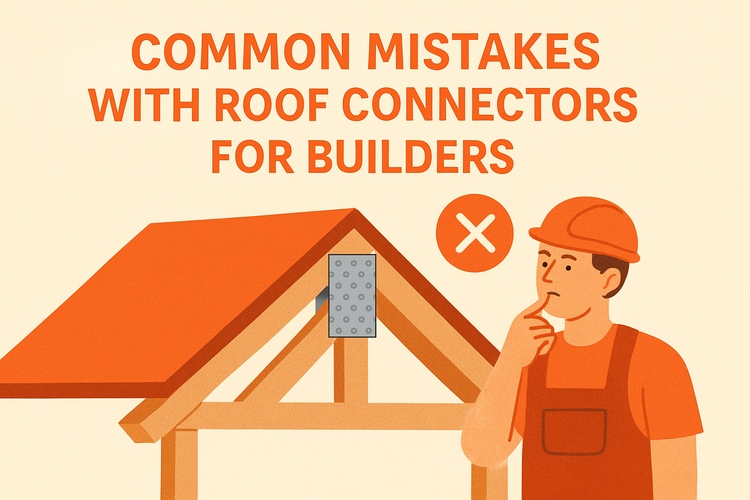Common Mistakes With Roof Connectors For Builders

Incorrect Placement of Roof Connectors
Improper positioning is a frequent error when installing roof connectors. Even slight misalignment can seriously impact load transfer and overall stability of the roof structure.
Roof connectors are engineered to distribute forces effectively, but only if they are aligned properly with structural components. Nails or screws driven into the wrong section of a truss or rafter can compromise the connection's integrity. Builders must follow manufacturer's guidelines to ensure connectors are not installed at incorrect angles or distances.
In roofing systems where joist hangers are used, incorrect placement can cause burdens to shift unevenly, increasing stress on joints and increasing the chance of structural failure. A simple mistake in angle or position can lead to complications requiring costly repairs.
Using the Wrong Type of Connector
Each roof connector is designed for specific applications. Using the wrong type can reduce performance and compromise safety.
For example, roof connectors are structurally rated for specific load types. Substituting with a connector not intended to handle uplift or lateral forces creates vulnerabilities in the structure. Builders should understand the different types of connectors like tiedowns, truss clips, and hurricane ties to make the appropriate selection.
Selecting the appropriate connector type is especially important in high wind-prone zones where forces on the roof are more intense. Products from the High Wind ties & timber connectors category can offer added protection in such environments and prevent premature roofing failure. Inappropriate substitutions not only violate regulations but also risk safety and insurance noncompliance.
Neglecting Corrosion Resistance
Connectors are often exposed to moisture, and ignoring corrosion resistance is a mistake that leads to early degradation.
Builders sometimes use untreated or incorrectly coated connectors in humid or coastal environments. Over time, this causes rust and weakens structural bonds. Galvanised or stainless steel options are more resilient and better suited for outdoor or damp locations, particularly along flashing or eaves.
Using the appropriate finish—whether hot-dip galvanised or zinc-coated—extends the life of the roof structure. It’s not just about aesthetics but long-term safety and maintenance. Choosing inferior or incompatible finishes compromises both the connector and the timber it attaches to, often leading to unnecessary repairs or replacements.
Improper Fastening Techniques
Incorrect fastening is another common oversight during connector installation. Whether it's using wrong nails or screws or under-driving fasteners, the structural impact is real.
Roof connectors require specific types and lengths of fasteners to achieve rated performance. Generic alternatives that do not match the specification provided by connector manufacturers may not hold up under structural stress. Screws and nails provided by trusted suppliers meet these load specifications and minimize the risks of failure.
Another issue lies in under-fastening or over-driving nails, both of which weaken the connector's hold. Builders must avoid using pneumatic guns that can drive fasteners too deep. Regular training and tool calibration are key to avoiding these repetitive errors on construction sites.
Skipping on Structural Reinforcement
Roof connectors alone aren’t always enough. Failing to complement them with supporting components can weaken the whole system.
When builders don’t incorporate restraint straps or lateral bracing in roof systems alongside connectors, the framework becomes vulnerable. These reinforcement tools work in unison with primary connectors to absorb movement and distribute stress effectively across the structure.
Secondary supports like post base products provide anchorage at the bottom that complements roof connections above, particularly in larger or multilevel structures. Skipping these can cause an imbalance in load path continuity, leading to compromised architectural strength.
It's important to consider long-term durability, especially in adverse weather conditions. Reinforcements add that extra degree of stability that separates a good build from a great one, improving the overall lifespan of the construction. Documented plans should always factor in both connectors and their complementary supports to ensure complete protection.
